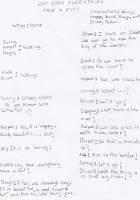Sunday, 16 May 2010
Act & Learn School Displays - Photo Flick
You can magnify the image with your mouse.
If you are interested, I have added some more information about the work done in the slideshow version.
Improving our student´s writing through drama
 What children can get from the drama and role-play activities goes beyond the speaking and listening because drama techniques are also a great way to help them improve their reading and writing skills.
What children can get from the drama and role-play activities goes beyond the speaking and listening because drama techniques are also a great way to help them improve their reading and writing skills. Very motivating writing activities (previous to the performance, which to the students is the ultimate goal,they just love it!) are:
- Writing short dialogues individually
- Writing scripts in small groups
- Writing songs and poems
- Writing a story in order to later develop a script
These images are examples of scripts my spanish Year 4 students have written. I was working on question formulation (which they find very hard) and proposed the following activity:
1. They got into groups of 4/5 and thought of a question they would like an answer t
 o
o2. They developed a story around, and trying to answer, that question.
3. They wrote the script. They had to include at least 8 more questions in the dialogues.
4. They assigned the characters and rehearsed the play.
5. They performed the play.
 If you are interested in knowing more about the effectiveness of this teaching strategy,
If you are interested in knowing more about the effectiveness of this teaching strategy, Wednesday, 12 May 2010
Poems: Octopus, Octopus

- Rhyme
- Rhythm
- Future with “Will”
- Question formulation
The poem is:
Octopus, octopus down in the sea,
How many arms can you show to me?
Only one, or will it be two?
Why are all of these arms on you?
Will it be three or will it be four?
Oh, dear me! Are there really more?
Will it be five or will it be six?
I think that my eyes are playing tricks.
Will it be seven or will it be eight?
Tell me, octopus, I cannot wait.
Octopus, octopus, down in the sea,
How many arms can you show me?
There´s something about octopuses that makes children love them particularly, I recommend you give this poem a go and see it for yourself!
If you are feeling adventurous, in the art class you can use body paint and the children can paint octopuses on their friend´s hands as seen in the picture.
If you are working on The Sea as a topic or simply want more poems, I suggest you visit this very useful website for more Sea Poems and many other things.
Act & Learn School Displays - Slideshow
As you will be able to see, aesthetic perfection is not what we are looking for. We want the children to be the ones making the decisions throughout the process, taking control.
I have added a short comment to most of them to contextualize them within the learning process.
What we always have to try is, in my opinion, to make sure that it is the children themselves who are in charge of the creative proccess and fully understand the connections between the different activities surrounding the theme in order to acquire a deeper and more meaningful understanding of it.
When we work on a topic, we try to do it with an interdisciplinary approach, by working on it in more than one content area, specially in art, english and science, which are the curriculm subjects we teach in english.
The photos can also be seen in the Act & Learn School Displays Photo Flick.
If you want to know more about the interdisciplinary approach to teaching and learning, and many other instructional strategies, go to Instructional Strategies Online.
Sunday, 9 May 2010
Why use drama in the English classroom?
To start off with, students do not feel the pressure that a more formal learning situation might create and thus they learn without realizing due to the more play-like and personalized nature of the task.
 Also, traditional teaching methodologies focus on the individual, even sometimes creating a competitive atmosphere.
Also, traditional teaching methodologies focus on the individual, even sometimes creating a competitive atmosphere.
On the other hand, in the drama classroom the work is usually done in groups, and students get to teach and learn from each other.
Children learn from their peers new structures, words or expressions whist bring out those they were unaware they knew by being so involved in the process and trying to be understood.
In the day to day classroom, students feel the desire to please the teacher through their correct usage of language but, from what I’ve seen, in the drama class students want to do well for a project they feel fully identified with, and as a result, fully involved in.
Instead of having to memorize or repeat unnatural set phrases, drama facilitates spontaneous language learning in a more contextualized environment and making it student-centered and meaning-centered. It also gives the students the possibility for individual expression and group negotiation, whilst simply having fun. I bet we all agree our students deserve it!
Thursday, 6 May 2010
Drama: Classroom experience - Video
This video shows a dramatized reading, lead and supported but the teacher who adopts the role of the narrator of the story. The children are using self-made masks, once again demonstrating that the drama class allows for both, the development of communication and creativity.
The students are obviously very motivated and involved in the activity as will be yours- guaranteed!
Obviously we would have to plan this activity differently if we had a full class, since they lose their concentration and involvement in the moment after a while because of having to wait for their line to come up, and that would defeat the whole point.
We could also think of ways of getting the students away from the text in order to explore the characters by using the space, their body language...
Masks are really good for shy students but I personally prefer not to use them too much, since we want to be able to hear their pronunciation properly and it is very important for them to explore facial gestures.
Also, we want the students to produce their own language, that is why we are facilitating a meaningful and motivating context, thus the drama class does not necessarily imply memorizing long scripts or obsessing about perfect grammatical structures.
You can find lots of tested and proven successful creative drama classroom lesson plans here.
Role-play: Classroom experience - Video
This video shows how easy it is to use role-play in the English classroom. On this occasion they have props, but the same activity could be done with the children’s coats and they would find it as motivating. We must not forget that what is really needed is right in front of us: their imagination and readiness to play.
This sort of activity should never be seen as a waste of valuable teaching time, because the target language will only be truly assimilated when it has been used for a real communicative purpose and incorporated as part of their meaningful personal experience.







